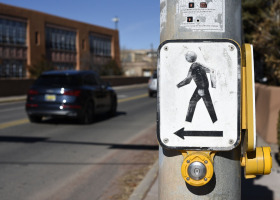- November 30th, 2023
- 0 Comments

"We're designing streets for the past, not for what we're currently seeing or trends that we can anticipate. This just seemed like such a common sense, sensible action the city could make," said Paul Kelterborn, author of the resolution in Brooklyn's Community Board 1.
The action is called "daylighting," a process that pays close attention to the schematics of the street where most crashes occur: the corners of crossings. The idea is that if intersections are clear of obstructions like parked cars, then drivers, pedestrians, and cyclists would all be able to see one another better—and better sightlines mean less likelihood of crashes.
Daylighting can take many forms: Curb extensions, painted or built out with concrete, and sometimes with rain-absorbing plantings, and more. Curbside cycling amenities like bike-share docs or micromobility racks (think e-scooters) are increasingly common, and outdoor dining sheds can help with daylighting, too. Other methods use granite blocks or giant concrete balls to create additional space at the corners of intersections, or even just affixing a "no parking beyond this point" sign can help.
As the U.S. contends with an ongoing surge in pedestrian deaths that has been reversing years' worth of traffic safety progress, proponents of the daylighting concept often point to the effectiveness in preventing the mRost common car-on-pedestrian crashes and say, "why not?"
The easier answer—as it often is—is parking. In many states, it is illegal to park up to a certain distance of the crosswalk, but in many cities, those traffic rules go unenforced.
Sufficient daylighting requires 25-feet of visibility, which may require removing a parking spot or two in some areas, so if the rule were observed on all four corners of an intersection, there's potential to lose as many as 8 parking spaces on a single block, which is one of the many reasons why some cities seek exemptions from the rule even if adopted by their home state.
From curb bumpouts to flexible bollards, bike racks, and prohibitive paint stripes, traffic planners can reference the Urban Street Design Guide from the National Association of City Transportation Officials for detailed information including design guidelines and best practices based on street geometry.
Read the complete article from Bloomberg here or check out another detailed article from Strong Towns documenting exactly how to daylight your city's intersections, and why it matters.
Source: Bloomberg
Related News:
- Americans are walking less as pedestrian deaths rise
- People are happier in a walkable neighborhood: Insights from the U.S. commuinty that banned cars













